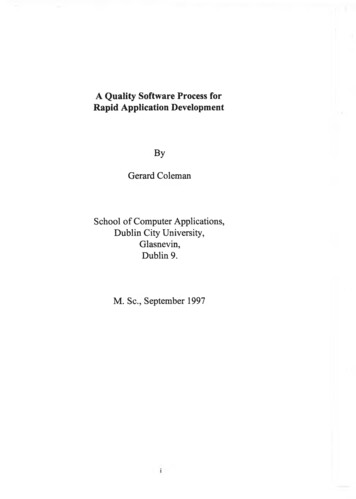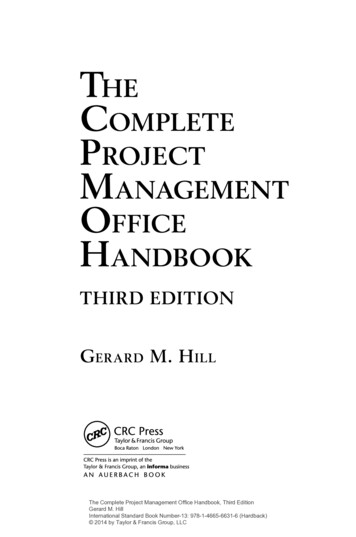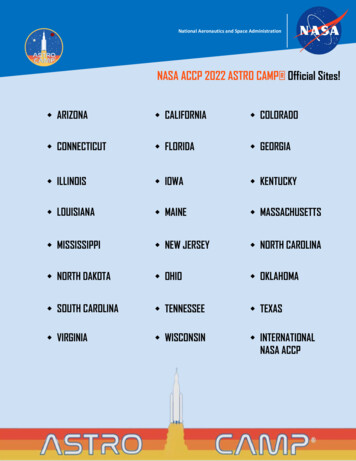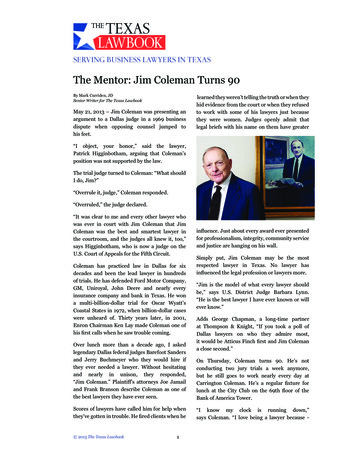
Transcription
A Quality Software Process forRapid Application DevelopmentByGerard ColemanSchool of Computer Applications,Dublin City University,Glasnevin,Dublin 9.M. Sc., September 1997
A Quality Software Process forRapid Application DevelopmentA Dissertation Presented in Fulfilmentof the Requirement for the M.Sc. DegreeSeptember 1997Gerard ColemanSchool of Computer ApplicationsDublin City UniversitySupervisor: Mr. Renaat Verbruggen
DeclarationI hereby certify that this material, which I now submit for assessment onthe programme of study leading to the award of M.Sc. is entirely my ownwork and has not been taken from the work of others save and to theextent that such work has been cited and acknowledged within the text ofmy work.Date:
AcknowledgementsI would like to thank Renaat for his assistance, insight and guidanceduring the research.I would also like to thank my wife, Fiona, for her encouragement andunderstanding throughout the compilation of this work.Finally, I would like to thank Patrick O’Beime, Shay Curtin and GerardMcCloskey who gave so generously of their time to review this work.iv
AbstractHaving a defined and documented standardised software process, together with theappropriate techniques and tools to measure its effectiveness, offers the potential tosoftware producers to improve the quality of their output. Many firms have yet todefine their own software process. Yet without a defined process it is impossible tomeasure success or focus on how development capability can be enhanced. To date, anumber of software process improvement frameworks have been developed andimplemented. However, most of these models have been targeted at large-scaleproducers. Furthermore, they have applied to companies operating using traditionaldevelopment techniques. Smaller companies and those operating in development areaswhere speed of delivery is paramount have not, as yet, had process improvementparadigms available for adoption. This study examined the software process in a smallcompany and emerged with the recommendation of the use of the Dynamic SystemsDevelopment Method (DSDM) and the Personal Software Process (PSP) forachieving software process improvement.DSDM has been designed as a framework for Rapid Application Development (RAD)and provides a documented approach for organisations to follow when undertakingRAD projects. Through the mechanisms outlined by DSDM developers becomeempowered and time-to-market for software can be substantially reduced.The PSP allows individual software engineers to assess, measure and improve theirperformance. By improving the skills of individual developers, quality can beengineered into RAD projects at all life-cycle stages.Combining PSP and DSDM, therefore, enables the production of high-qualitysoftware and at the same time allows reductions in development time to be achieved.
Table of ContentsChapter 1 - The Software Process. 11.0 Introduction. 11.1 What is the Software Process?. 21.2 Background. 31.3 The Software Process - Maturity and Assessment. 61.3.1 Process M aturity. 61.3.2 A Maturity Framework and the Capability Maturity M odel. 71.3.3 ‘Bootstrap’ . 91.3.4 SPICE. 101.4 Dynamic Systems Development Method (DSDM). 101.5 Personal Software Process (PSP). 111.6 Summary. 11Chapter 2 - Rapid Application Development (RAD) and the DynamicSystems Development Method (DSDM ). 122.0 Introduction.122.1 Rapid Applications Development (RAD). 122.2 RAD - A Worthwhile Investment?.122.3 Dynamic Systems Development Method - A RAD Standard.192.4 DSDM - What the Method Contains.202.5 Principles of D SD M .202.5.1 Applications Suited to the DSDM Approach. 212.5.2 Applications Unsuited to the DSDM Approach. 212.5.3 DSDM Implementation - Critical Success Factors. 212.6 The DSDM Life-Cycle. 222.6.1 Prototyping within DSDM . 242.7 Quality Issues in DSD M . 252.7.1 Quality Control. 252.7.2 DSDM and the CM M . 252.8 Introducing DSDM into an Organisation. 252.9 DSDM - A Way Forward for RAD?.26
2.9.1 Other Factors which May Influence Development.2.10 DSDM -The Benefits.2.11 Summary.Chapter 3 - Process Improvement using the Personal SoftwareProcess (PSP).3.0 Introduction.3.1 Personal Software Process (PSP).3.2 PSP Improvement Phases.3.3 The Baseline Personal Process.3.3.1 PSP0.1.3.4PSP1.3.4.1 Proxy-based Estimating.3.4.2 Resource and Schedule Estimating.3.4.3 Measurements in the P S P .3.5 PSP2.3.5.1 Design and Code Reviews.3.5.2 Software Quality Management.3.5.2.1 Product Quality.3.5.2.2 Process Quality.3.6PSP3.3.6.1 Scaling Up the Personal Software Process.3.6.2 The PSP3 Approach.3.7 Using the Personal Software Process.3.8 Personal Software Process - An Analysis.3.9 Summary.Chapter 4 - Assessment of the Software Process within aSmall Company.4.0 Introduction.4.1 Software Process Questionnaire .4.2 Questionnaire Findings.4.2.1 Project Review and Sign-Off.4.2.2 Configuration M 14141424349525252535556
4.2.3 Software Estimation. 564.2.4 M etrics. 564.2.5 Education/Training. 574.2.6 Project Management. 574.2.7 Software Quality Assurance. 584.2.8 Requirements Specification. 584.2.9 System Design. 594.2.10 Implementation. 594.2.11 Testing. 604.2.12 Operations/Maintenance. 604.3 Analysis of Findings. 604.4 Summary. 62Chapter 5 - Evaluation of the Development Environment within aSmall Software Company . 635.0 Introduction.635.1 Process Assessment - Environment Evaluation.635.2 Development Strengths and Weaknesses within the Company665.2.1 Development Strengths. 665.2.2 Development Weaknesses. 665.3 Comments on the Development Process. 695.4 Starting Point for an Improved Process. 695.4.1 The Requirements Document. 715.4.2 The Test Plan. 725.4.3 Using Fault Reporting. 725.4.4 Change Request Form . 735.5 Summary. 74Chapter 6 - A Software Process for R A D . 766.0 Introduction. 766.1 Implementing a Software Process for RA D .766.2 Using DSDM within the Company.786.3 How Will using DSDM Benefit the Company?. 806.4 Using PSP within the Company. 82viii
6.5 A New Development Environment. 836.5.1 A Quality Software Process for RAD - CombiningDSDM and PSP3. 846.5.2 A Quality Software Process for RAD - Using Proxies.866.5.3 A Quality Software Process for RAD - Testing. 886.5.4 A Quality Software Process for RAD - A Quality Plan.896.5.5 A Quality Software Process for RAD - M etrics. 916.5.5.1 Defect M etrics. . 946.5.5.2 Productivity M etrics. 966.5.5.3 Size M etrics.986.5.5.4 Time/Schedule M etrics. 996.5.5.5 Extended M easures. 1026.5.5.6 Cost of Quality (COQ). 1046.5.6 Maintenance. 1056.5.7 Software R euse. 1076.6 Summary. 109C hapter 7 - Independent Review. I l l7.0 Introduction. I l l7.1 Review Panel.I ll7.2 Independent Review Comments.I ll7.3 Summary. 118C hapter 8 - Conclusions.1198.0 Introduction. .,. ,. 1198.1 Detailed Analysis. 1198.2 Recommendations. 1218.2.1 Data Recording Assistance. 1218.2.2 Inspection/Review Assistance. 1228.2.3 DSDM Software Process Improvement Measures. 1228.3 Future Research .1229. R eferences. 125Appendix A . 130Appendix B .131
Appendix CAppendix D
List of Figures1.0 Waterfall M odel.1.1 Spiral Process M odel.1.2 Process Maturity Framework.2.0 DSDM Life-Cycle.2.1 DSDM Prototyping Cycle.3.0 PSP Evolution .3.1 PSP3 Process.4.0 Company Process Maturity C hart.5.0 Company Development Paradigm.458232436425565List of Tables2.0 Advantages and Disadvantages of Prototyping. 182.1 Advantages and Disadvantages of R A D . 192.2 DSDM - Critical Success Factors. 222.3 Summary of Inspection D ata.273.0 Object Category Size in L O C . 385.0 Company Strengths and W eaknesses.665.1 Company Weaknesses - Standardisation and Procedures. 676.0 Factors which favour DSDM U sage. 796.1 Factors which favour PSP U sage.836.2 Defect Type Standard.936.4 List of M etrics.94XI
Chapter 1 - The Software Process1.0 IntroductionThis study examines the different approaches which can be taken to develop softwarewith a view to proposing a methodology for use in small software companies. Manycompanies possess a backlog of software waiting to be developed. Much of thisbacklog exists because companies must devote large resources to maintaining existingsoftware. This can occur, either through enhancement of existing systems or, throughhaving to fix systems of poor quality.These problems are particularly acute in small companies.To try and reduce the backlog and address this ‘software crisis’ companies are using anumber of approaches. These include improving the quality of developed software sothat less time and resources are spent fixing defects and using Rapid ApplicationDevelopment (RAD) techniques to speed up the development process [MART91].The objective of this study is examine this ‘software crisis’ as it exists in smallsoftware companies and to propose a software process framework suitable for suchcompanies who wish to get quality software products onto the market as quickly aspossible. The research involved the study of software processes and methods suitablefor use in small companies. Also a small software development company wasexamined to determine the methods and processes it used and subsequently how anysuitable software process paradigms might be applied within such an environment.The study concludes by proposing the use of a combination of the Dynamic SystemsDevelopment Method (DSDM) [DSDM95], a life-cycle for use in RAD environments,and the Personal Software Process (PSP) [HUMP95] which is targeted at improvingthe performance of individual software developers.1
1.1 What is the Software Process?Many companies, particularly small and medium-sized enterprises (SMEs), developsoftware in an unstructured and undefined way. The set of approaches andmechanisms which organisations use to develop software is known as The SoftwareProcess.Every organisation has its own particular software process. Some are based ontraditional development models such as the Waterfall Model [ROYC70] whilst othershave evolved from historical company practices.In order to improve its software capability each organisation must have a defined anddocumented software process. However, many different process models exist andhave applicability in different environments. Some models, such as the CapabilityMaturity Model (CMM), assess the ‘maturity’ of software development organisations[HUMP88]. The CMM basically indicates that the more mature a softwaredevelopment organisation, the more capable it is of developing high-quality software.Unfortunately, many companies operate without a defined process, with each softwaresystem being developed independently without regard for previous or concurrentdevelopments.As such, the quality of the finished product depends primarily on the assiduity of thedevelopment personnel, their design and programming skills and commitment tocomprehensive testing.Also, any methods, or tools, to support the process are used in an unstructured andhaphazard fashion. Further, it is unlikely that any metrics will be collected.Boehm defined software engineering as:‘The application of science and mathematics by which the capability of computerequipment is made useful to man via computer programs, procedures and associateddocumentation’ [BOEH76].A process, Humphrey states, is a series of tasks, that when properly executed,achieves the desired result [HUMP88].2
Ultimately, the manufacture of software can be reduced to a list of tasks that must becarried out in a certain sequence. However, if the desired result is software ofmeasurable quality then it is necessary to adopt an engineering-style approach to thecreation of that product.1.2 BackgroundIt has taken a long time for the idea that software should be developed within amature, managed process, to become established.In 1987, Brooks claimed that, at that time, there did not exist a single development ineither technology or management technique that promised a significant improvementin software engineering but, notwithstanding that, a coherent and consistent attempt toexploit and incorporate new technologies should produce that improvement[BR0087]. Prior to the emphasis on the software process and software engineeringapproaches, designing an appropriate model for software development was the majortask.In 1956, Benington proposed the stagewise model which suggested a series of phasesalong which development would proceed [BENI56].Royce expanded on this to produce the Waterfall model [ROYC70]. The Waterfallmodel became the standard approach to software development for many subsequentyears and is still in wide use today.3
The layout o f the Waterfall model is shown in Figure Figure 1.0 - The Waterfall ModelWhat the model shows is essentially a series of progressions through discrete stages,from system inception through definition of requirements, analysis, design andcoding, testing and then final delivery of systems.On the whole the model has proved a successful management tool and has laid thefoundation for structured software development, however, its rigid hierarchy andinflexibility has led to the creation of alternatives.In attempting to address the deficiencies contained within the Waterfall model, Balzeret al. proposed the Transform model [BALZ83]. The Transform model is based on theproduction of a formal specification of a software requirement and the subsequentconversion of that specification into a working program matching the specification.The model also incorporates the facility to amend the specification based onoperational experience. The advantage here is that, as the code is regenerated, italways matches the specification.4
However, this technique may only be used at present in limited application areas andunplanned evolutionary paths may be difficult to incorporate.In 1986, Barry Boehm developed what he termed a ‘Spiral’ model (Figure 1.1) forsoftware development, which though essentially based on the Waterfall model,attempted to incorporate the best features of all the preceding models [BOEH88].The key difference with the Spiral model and its predecessors is the fact that it is riskdriven, rather than document- or code-driven. The Spiral model moves from the centreout and works as follows :Each stage begins with determining the objectives for that stage, the alternativeapproaches which can be taken and the evident constraints. The alternatives are thenevaluated and the associated risks are identified and resolved.Development and verification of the product then follows and finally planning of thenext phase is carried out. Each cycle of the spiral terminated by a review.Figure 1.1 - The Spiral Process Model [BOEH8815
The exposed limitations of the Waterfall model led to the formulation of theEvolutionary Development model [McCR92]. This model is well placed to takeadvantage of fourth-generation languages as essentially an initial version of a softwareproduct is produced rapidly, evaluated, the amendments incorporated and a newversion speedily created. However, the evolutionary development model possesses itsown limitations in that its code/test/fix procedure can lead to a planning deficit.Software development or life-cycle models can teach us a lot about the creation ofsoftware and the steps required. However, to ensure continued success across alldevelopment areas, these models need to be incorporated as part of an effectivesoftware process.1.3 The Software Process - Maturity and AssessmentIn the 1980s, when it became apparent that deficiencies in managing development andmaintenance were hindering the improvement of software productivity and quality,the move towards a software process began.1.3.1 Process MaturityProcess maturity is intrinsically linked to the concept of quality management.Thompson and McParland state that a mature organisation has a well-defined softwaredevelopment process and measures both the quality of the process and the products itcreates [THOM93]. Gauging the maturity level of an organisation is achieved byusing assessments to analyse the competence or capability of an organisation’sdevelopment process.Curtis and Paulk proceeded to differentiate the mature organisation from the immatureone [CURT93]. Accordingly, they state that the mature organisation possesses theability to meet its cost, quality and schedule targets.6
However, the failures of the immature organisation are legion: Processes are improvised during projects. Unrealistic assumptions are made about project and phase completion dates. Because of these unrealistic assumptions product functionality is oftenjettisoned in a desperate attempt to meet deadlines. Success depends totally on the commitment and talent of the developers. The final products often contain many errors, incomplete documentation andthe delivery lacks rudimentary configuration management.The mature organisation, by contrast, has a well-defined, carefully managed processin place and this process is communicated to all employees. Thus, employees have aclear understanding of their roles/responsibilities.All developments are planned and the process ensures the plan is adhered to in allrespects. Quantitative methods are used to judge the quality of the software product.Finally, when new technology is to be introduced or developed, the process can besimply adjusted to cater for this.1.3.2 A Maturity Framework and the Capability Maturity ModelSeveral bodies, most notably the Software Engineering Institute (SEI) have been inthe vanguard of promoting assessments of organisations and the evaluation oforganisations’ software development capability.The SEI developed a Maturity Framework which included two methods, softwareprocess assessment and software capability evaluation, plus a maturity questionnaireto appraise software process maturity [HUMP88].The assessment helps in finding the maturity level of the organisation’s process whilethe questionnaire examines in great detail all aspects of software developmentincluding methodologies and tools used.Endeavouring to illustrate this improvement path for customers, the SEI categorisedorganisations under five headings denoting their level of maturity [Figure 1.2].7
LEVEL 5OPTIMISINGProcess ControlLEVEL 4MANAGEDProcess MeasurementLEVEL 3DEFINEDProcess DefinitionLEVEL 2REPEATABLEBasic Management ControlLEVEL 1INITIALFigure 1.2 - Process Maturity FrameworkAt Level 1 ‘Initial’ the development process is chaotic and unstructured.From levels 2 through 5 organisations are attempting firstly to establish and thensubsequently improve their development process.
At Level 2 ‘Repeatable’ , the overall objective is to ensure that successful techniquesand approaches utilised on previous projects can be assimilated and used on currentand indeed future developments.Level 3 ‘Defined’ - At this level companies now focus, rather than on specificprojects or project management techniques but on process and ensuring its integrationthroughout the organisation. The emphasis now is on process definition andimprovement and on equipping all software engineers and managers with the skillsand tools required to execute their roles effectively.Level 4 - ‘Managed’ - Here, software measurement is introduced to assist inmanaging the quality of the process itself and the software product.Level 5 - ‘Optimising9 - Having achieved the previous four maturity levels, theorganisation can now focus on continuous quality improvement.After extensive work in this area the SEI evolved the Maturity Framework into theCapability Maturity Model (CMM) [PAUL93]. The CMM is based on theknowledge acquired from these studies and specifies recommended practices in theparticular areas that have been shown to enhance software development andmaintenance capability.1.3.3 ‘Bootstrap’It would be incorrect to conclude that the work being carried out by the SEI was theonly development in this area. Work has recently been ongoing in Europe.‘Bootstrap’ was a project completed as part of the European Strategic Programme forResearch in Information Technology. Its objective was ‘to develop a method forsoftware process assessment, quantitative measurement and improvement’[HAAS94]. In doing so, ‘Bootstrap’ took the model developed by the SEI for processassessment and tailored it for use in the European Software arena. The key aspects of‘Bootstrap’ are : Questionnaires are created to establish the organisation’s/project’s maturity level. Organisations are encouraged to create a software engineering process modelbefore setting up a quality system.9
Unlike the SEI method which expects certain attributes to be evident atcertain maturity levels and to rate companies accordingly, 'Bootstrap’ ratesthe attributes irrespective of the level at which they occur. The maturity of the organisation is more important than the maturity of thetechnology or the methodolog
Development Method (DSDM) and the Personal Software Process (PSP) for achieving software process improvement. DSDM has been designed as a framework for Rapid Application Development (RAD) and provides a documented approach for organisations to follow when undertaking RAD projects. Through the mechanisms outlined by DSDM developers become










